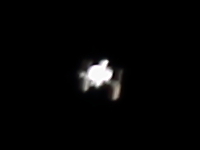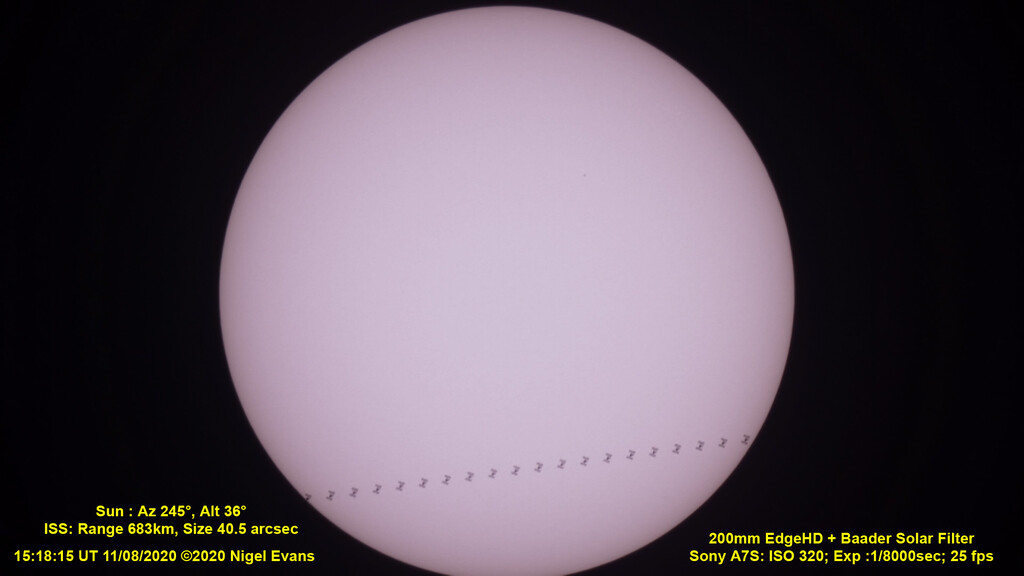
Orwell Astronomical Society (Ipswich)
ISS, 06 August 2013 - 27 May 2023
The ISS (International Space Station) orbits at an altitude of approximately 415 km above the surface of the Earth. It is a very difficult object to image because of its relatively small physical size (approximately 108x72 m) and rapid movement. When the ISS transits the Sun or the Moon, the results are visually impressive; however, such events are infrequent. The best images of the ISS obtained by members of OASI are below.
For further information on imaging the ISS, see https://skyinspector.co.uk/imaging-the-iss.
A video of the ISS transitting the Moon. The duration of the transit was 0.6 s. The event was predicted by the ISS transit finder website: https://transit-finder.com.
Skywatcher PDS 200 mm telescope and ZWO ASI178mm camera.
A video of the ISS transitting the Sun. The duration of the transit was 1.7 s. The event was predicted by the ISS transit finder website: https://transit-finder.com.
Lunt LS60THa/B1200 solar telescope and ZWO ASI178mm camera.
A check on spaceweather.com revealed a single small sunspot, approximately half a solar radius from the centre, at about 1 o'clock. It took a while to find it but, once found, I used it to focus my camera. As the transit lasted less than a second, the video has been looped several times.
An image of the ISS during a passage at 82° altitude, taken at 21:07 UT on 24 May 2020. Canon 1200D attached to a Meade 200 mm LX200. 1/250 s exposure at ISO 400.
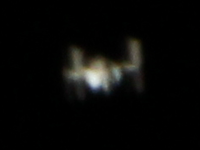
The Sun is still featureless. Some cirrus clouds reduced contrast in the image, making the sky around the Sun appear not so dark.
I captured a video of the transit of the ISS across the Sun in Hα light using a Lunt LS60THa/B1200 and ZWO ASI178mm camera. I was able to achieve good focus using solar features visible in Hα.
On a beautiful sunny Easter Saturday there was another opportunity to record the ISS, this time at a distance of some 900 km crossing the face of the Sun. In white light, the Sun was completely featureless, making the solar limb the only object to use for focussing. (When the ISS transits the Moon, the entire lunar disk can be used for focussing - giving better results.) The focus is a little soft, but nevertheless the main solar panels can be made out.
I obtained three images of the ISS from a pass on Friday 27 March 2020 at 19:41 UT. From my location, the craft was almost overhead, at an altitude of 82°, and difficult to track. Equipment used: Canon 1200D, 1/125 s exposure at ISO 200. Meade 200 mm LX200, moved manually. The best image is below.
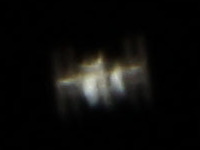
From my location, the transit took place at relatively low altitude, and I was unsure if I would be able to see it from my observatory, so I set up an additional secondary station elsewhere in the garden. Because the event occurred at low altitude, the ISS was almost 1200 km distant and appeared to be moving relatively slowly. Atmospheric conditions were not ideal, with high altitude haze.
Top video: at the secondary station, I used a Canon 60Da with 600 mm telephoto lens on a fixed tripod. It showed the ISS as little more than a dot. The Moon moved significantly during the seven seconds of the video clip, so I have aligned the images on the lunar disk.
Bottom video: in the observatory, I used a Sony A7S with a driven 200 mm Celestron which, at f/10, gives a much larger image scale. The detail is not stunning, but the solar panels are visible.
My first attempt at imaging the ISS. Taken on 24 May 2019 at 20:37 UT with a Canon 1200D attached to a 200 mm Meade LX200. I moved the telescope by hand. Thirty-five exposures at 1/500 s, ISO 800, processed in PIPP and stacked in Registax 6. (Thanks to Martin Cook for advice on processing.)
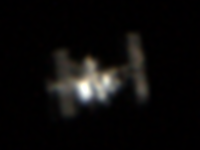
The ISS transitted the Moon as seen from Ipswich on 31 August 2018, at approximately 06:18 UT.
The following video is slowed by a factor of eight to make the transit more easily visible. The image is inverted. The bright ray crater towards the top right is Copernicus, with Eratosthenes to the left and Herodotus to the bottom right. Skywatcher 200PDS 200 mm, f/5 Newtonian on HEQ5 mount and QHY5L-II colour camera.
After several attempts, plus several more washouts due to the weather, a successful recording of the ISS transiting the Moon, albeit in daylight. 200 mm, f/10 Celestron Edge HD Schmidt-Cassegrain and Canon 60Da camera at ISO 3200, 1/4000 s exposures at 25 fps.
The ISS was predicted to transit the Moon, as seen from my home, on 30 May 2017 at approximately 21:06 UT. The Moon was five days old and the predictions showed the object crossing only the dark side. I therefore aimed to produce an image of the dark side with an overexposed ISS in transit. Unfortunately, the result (below) is a slightly blurred ISS in front of an invisible Moon. Indeed, examination of a stack of individual frames suggests doubt that the ISS fully entered the dark side. So, back to the drawing board then!
The LHS picture is a composite of frames captured during the transit, taken at 5 frames per second. The RHS image is a close up taken afterwards when the ISS was overhead. Taken with a Canon 60Da camera and 2x Barlow lens on a F5 200 mm Helios tube Dobsonian telescope. 1/250 s exposure at ISO 3200.
The ISS was forecast to transit the Moon at approximately 20:07 UT on 11 October 2016. I realised that (weather permitting) the event would be visible from my observatory and, two nights in advance, I performed a trial imaging run with my Canon 60Da in video mode. The weather forecast for the evening of 11 October was poor but, as the evening wore on, there was the promise of gaps in the cloud, so it would be luck as to whether or not I would see the transit. With a few minutes to go the sky became quite clear in the south, with a westbound bank of cloud below the Moon.
So did I see the transit? I watched the screen of the back of the camera and saw nothing but, going slowly through the video file, I saw that the camera had captured it. Below are the edited "highlights", showing a moving smudge crossing the Moon at the right time with the appropriate track, from about 4:30 to 7:00 (on a clock-face). The chief failing was that the video frame exposure was at 1/60 second, far too long to stop the motion of the ISS and avoid blurring. Note to self for next time: highest ISO, shortest exposure.
David and other observers from OASI gathered at Priory Park to try to observe the transit. Unfortunately, they were thwarted by a cloud which obscured the Moon only five seconds before the event! The images below were taken shortly after the transit, at 20:30 UT. (The terrestrial scene is illuminated by moonlight.)
The ISS passed in front of the Moon at 20:28:46 UT. Images taken with a Canon 1100D camera, 400 mm telephoto with x3 converter, ISO 1600, 1/250 s exposure. The camera was mounted on a tripod and Alan hand-tracked the ISS from first appearance in the west to just past the Moon, taking 366 shots in a continuous burst at about 3 frames/s. The top two images show the ISS immediately before and immediately after passing in front of the Moon; the montage of five images shows the progress of the ISS across the face of the Moon. The ISS took approximately 800 ms to cross the face of the Moon.
 Transit across the lunar disk.
Transit across the lunar disk.
Video taken with Canon 1100d on Skywatcher 200mm.
The ISS passing Jupiter at 22:30 UT. Canon 60Da camera with 2x Barlow and coma corrector on 200 mm f5 Helios tube Dobsonian. Series of 1/1000 s frames at ISO 3200. First four frames captured at 5.3 fps; remaining frames captured at lower rate due to buffering.
The ISS passing Jupiter at 22:30 UT. Nikon D3200, 300 mm lens, conditions quite good, no post-processing of video.
200 mm Skywatcher 200PDS Newtonian with 2x Barlow on unlocked HEQ5 mount. Hand-guided with 70 mm refractor. ISO 800. Exposure times in range 1/250 - 1/350 seconds. Canon 1100D DSLR.
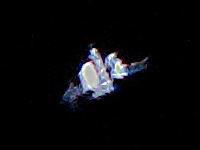 15 April 2014.
15 April 2014.
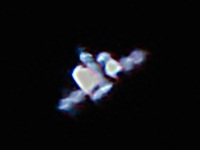 15 April 2014.
15 April 2014.
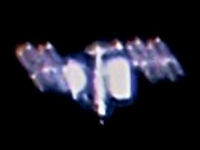 14 April 2014.
14 April 2014.
200 mm Dobsonian, hand-guided, Canon 1100D DSLR.
